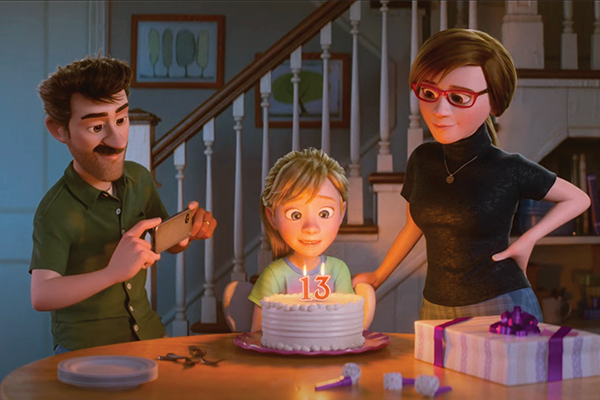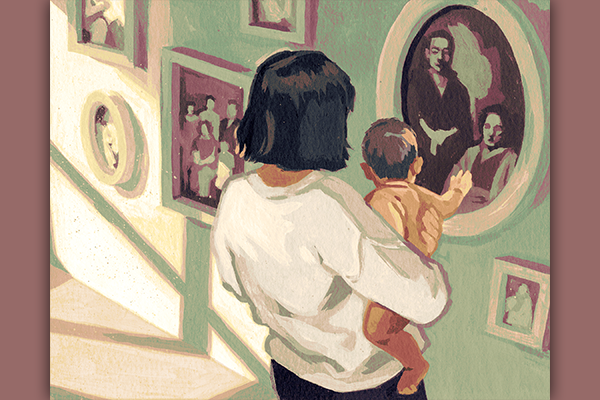THE BIBLE REPEATEDLY points us toward understanding God as a parent. Jesus recommends we call God “Dad,” or “Abba” in Aramaic (Matthew 6:9), and compares himself to a mother “hen [who] gathers her chicks under her wings” (Luke 13:34). And in the Hebrew scriptures, God often appears as a parent. Consider this description of God’s relationship to us from Hosea 11:3-4 and see if you don’t get a little misty-eyed: “Yet it was I who taught Ephraim to walk; I took them up in my arms, but they did not know that I healed them. I led them with cords of human kindness, with bands of love. I was to them like those who lift infants to their cheeks. I bent down to them and fed them.”
As a parent, I get glimpses of that love: The joy I felt watching my daughter score her first goal in soccer. The worry I felt when I saw her fight through a string of stomach bugs. But most surprisingly, I’ve caught glimpses of God’s parental love when watching kids’ movies with my child, particularly films from 2024.
One moment in particular, a scene from Despicable Me 4, of all things, really hammered home the link between parenting and God. Throughout the film, the main character, Gru, struggles to connect with his son, Gru Jr. When Gru Jr. finds another father figure, someone who will bring harm to Gru, Gru still offers his child one last gift by saying, “It’s okay, Junior. Dada loves you.” There was something about that scene showcasing the fierce love of a parent for their children, even when that love hurts, that made me understand that movies, especially kids’ movies, can be a fantastic way to gain some understanding of what God’s love might look like.
Of course, becoming a parent is not the only way to understand God’s love, and unfortunately, many kids have parents who, through neglect or abuse, fail to emulate God’s parental love. But parenting is still a remarkable, unique experience filled with insight, and these movies — IF, Inside Out 2, and Harold and the Purple Crayon — showcase parents wrestling with how to demonstrate unfailing love in a fallen world.
IF is a magical adventure set in a universe where Imaginary Friends, called “IFs” in the movie, are real, but most adults stop seeing them as they grow up. Bea, the main character, who can see not only her IF, but also everyone else’s, attempts to rebuild connections between adults and their long-forgotten imaginary friends.
IF is probably best known for the giant purple imaginary friend who graced posters and promotional materials, but one of the central tensions within the movie showcases a relationship between Bea and her father. For most of the film, her dad, who is sick with a heart condition, is in the same hospital where her mother passed away. Still, he continues to encourage imaginary play for his daughter, who believes she is too grown-up and worldly for imagination: He pretends to rappel out the window of his hospital room; he hides in a closet to elicit laughs; he dances with a mop and IV drip. Bea’s father creates joy in a place of sorrow, demonstrating how we can always imagine more than our current struggles.
As a parent, God also invites us to imagine a reality that cannot be seen. So much of what God invites us to imagine is simply beyond our present understanding — it requires new ways of thinking and being. In God’s world, the last are first, the rich are sent away empty, and the sinners enter the kingdom of heaven before religious authorities. Such a world requires imagination, and God is continually fostering that in our lives.
Inside Out 2 is a more cerebral (pun intended) film, featuring anthropomorphized emotions inside 13-year-old girl Riley’s brain. Here, Anger is a small, red, glaring figure who is liable to literally blow his top. Sadness, conversely, is blue and slouching, while Anxiety is wiry and full of the sort of energy that those of us who deal with anxiety know all too well. These emotions all vie for access to the control panel of Riley’s mind as she enters puberty, with predictably unpredictable results. Of course, Riley’s parents do not have access to the visualizations that we, the viewers, have. They instead must rely on compassion when dealing with their daughter’s outbursts. In one scene, when Riley screams at her mother and then immediately bursts into tears, we get a brief image of her mother’s reaction: “Well, that’s a preview of the next 10 years,” she quips, before immediately attempting to comfort Riley. She offers support, even as Riley pushes her away.
The remarkable amount of compassion demonstrated by Riley’s parents throughout the movie ought to be familiar both to anyone raising teenagers and to readers of the Bible. Time and time again, God reaches out to those who are angry, disaffected, or just plain uninterested in what God has to say. Even when God seems near the end of God’s rope, there are moments of reprieve; disaster is delayed, or averted altogether. Take for example, God delaying judgment for many years because of one king, Josiah, and his righteousness (2 Kings 22:15-20). God takes no delight in rendering punishments because the relationship that God has with Israel is that of child and parent.
In Harold and the Purple Crayon, the parental figure is a never-seen voice who acts as the narrator for Harold, a boy who can bring anything to life with his signature purple crayon. But early in the movie, the narrator, known as “the old man,” suddenly goes absent. Instead of giving instructions, the old man falls silent, and the movie is Harold’s search for meaning in the absence of what we might call divine revelation. All of us have had instances where we yearn to hear from God and are instead met by silence. However, toward the end of the film, Harold has an opportunity to learn one more bit of wisdom from “the old man,” who is revealed to be Crockett Johnson, the author of the children’s book that inspired this movie. Harold discovers a (fictional) note that Johnson penned before he passed away. It reads, “We only have so much time in this world, but we leave our mark in the lives we change.”
Even in his absence, this parental figure gives guidance. That seems quite close to what we have in church: letters and writings to go by when we lack a narrator. If we seek it, we will find guidance. After that, we have to make our own way, just like Harold learns to do.

Got something to say about what you're reading? We value your feedback!







